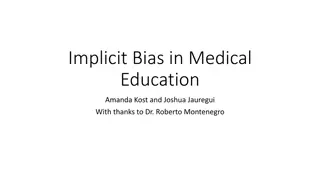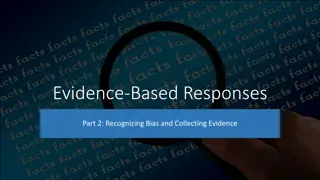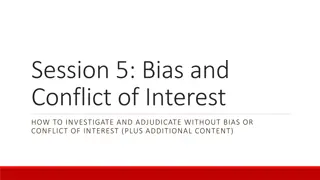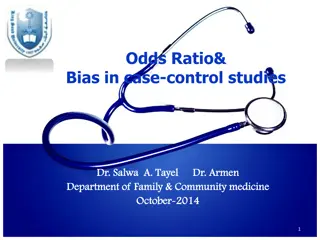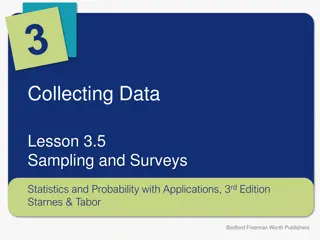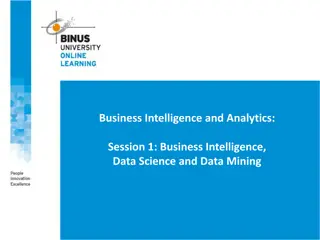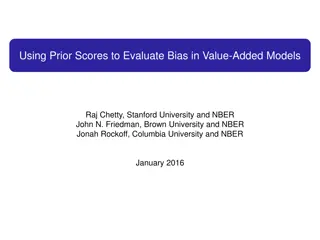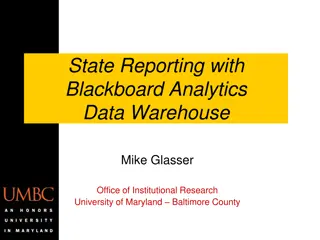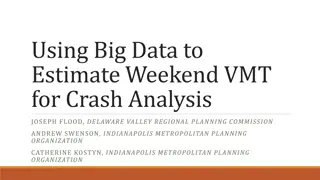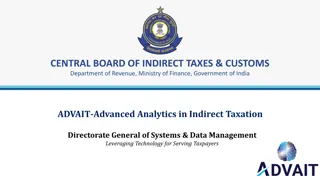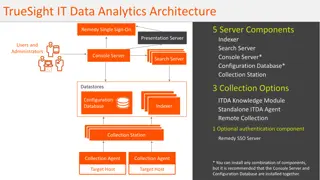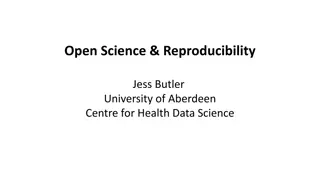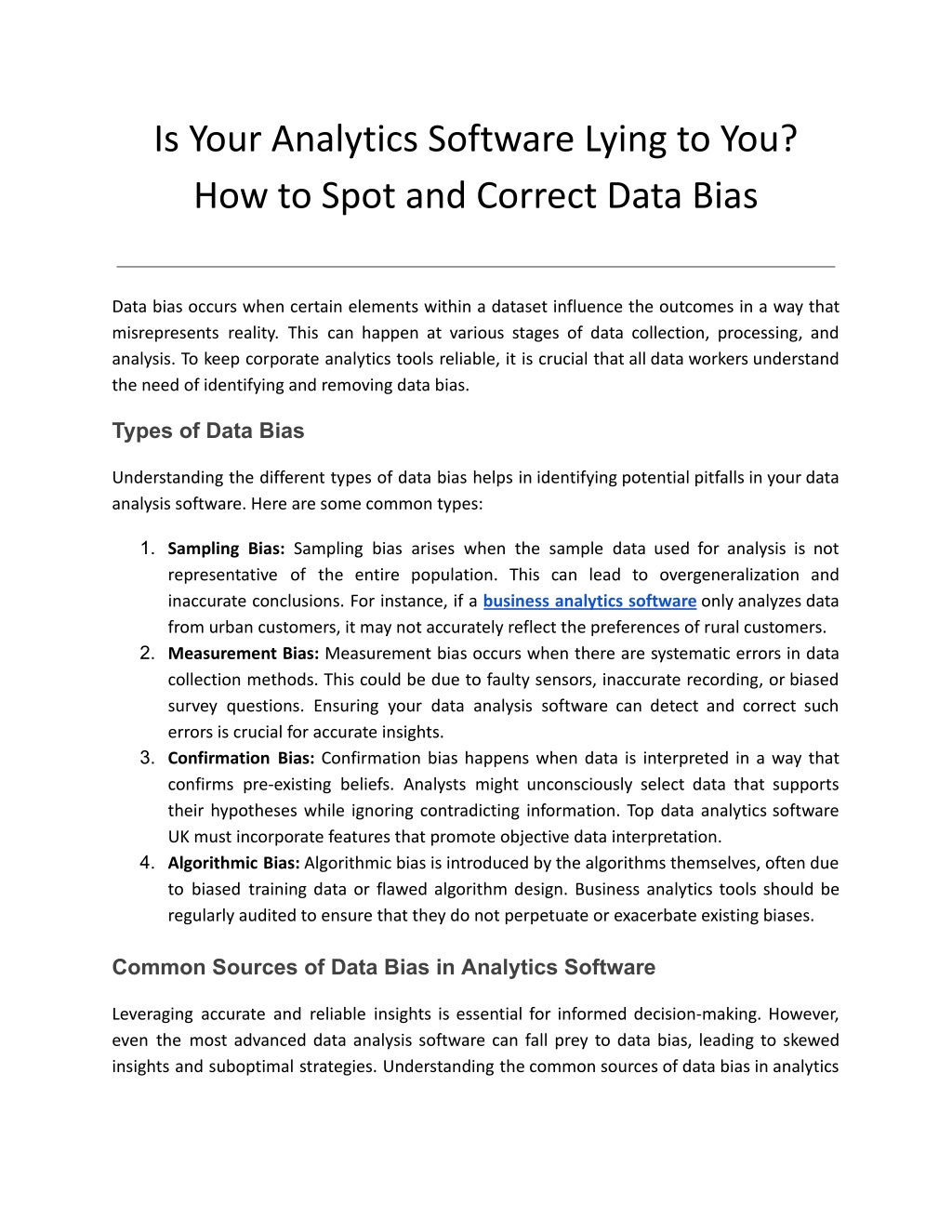
Is Your Analytics Software Lying to You_ How to Spot and Correct Data Bias
Data bias can distort your analytics and lead to misguided decisions. In this blog, learn how to identify common signs of data bias, understand its impacts, and explore effective strategies to correct it. Enhance the accuracy and reliability of your insights with practical tips and advanced tools, ensuring your business analytics software delivers true, actionable information. Don't let data bias mislead your strategyu2014read on to find out how to keep your analytics trustworthy and impactful.Sign up for a 14-day free trial and discover how our solutions can transform your data analytics. And fo
Download Presentation

Please find below an Image/Link to download the presentation.
The content on the website is provided AS IS for your information and personal use only. It may not be sold, licensed, or shared on other websites without obtaining consent from the author. Download presentation by click this link. If you encounter any issues during the download, it is possible that the publisher has removed the file from their server.
E N D
Presentation Transcript
Is Your Analytics Software Lying to You? How to Spot and Correct Data Bias Data bias occurs when certain elements within a dataset influence the outcomes in a way that misrepresents reality. This can happen at various stages of data collection, processing, and analysis. To keep corporate analytics tools reliable, it is crucial that all data workers understand the need of identifying and removing data bias. Types of Data Bias Understanding the different types of data bias helps in identifying potential pitfalls in your data analysis software. Here are some common types: 1. Sampling Bias: Sampling bias arises when the sample data used for analysis is not representative of the entire population. This can lead to overgeneralization and inaccurate conclusions. For instance, if a business analytics software only analyzes data from urban customers, it may not accurately reflect the preferences of rural customers. 2. Measurement Bias: Measurement bias occurs when there are systematic errors in data collection methods. This could be due to faulty sensors, inaccurate recording, or biased survey questions. Ensuring your data analysis software can detect and correct such errors is crucial for accurate insights. 3. Confirmation Bias: Confirmation bias happens when data is interpreted in a way that confirms pre-existing beliefs. Analysts might unconsciously select data that supports their hypotheses while ignoring contradicting information. Top data analytics software UK must incorporate features that promote objective data interpretation. 4. Algorithmic Bias: Algorithmic bias is introduced by the algorithms themselves, often due to biased training data or flawed algorithm design. Business analytics tools should be regularly audited to ensure that they do not perpetuate or exacerbate existing biases. Common Sources of Data Bias in Analytics Software Leveraging accurate and reliable insights is essential for informed decision-making. However, even the most advanced data analysis software can fall prey to data bias, leading to skewed insights and suboptimal strategies. Understanding the common sources of data bias in analytics
software is crucial for business users, data analysts, and BI professionals to ensure the integrity of their analyses. 1. Data Collection Methods Inadequate Sampling: Data bias often begins at the data collection stage. If the sample data is not representative of the entire population, the insights generated by your data analysis software will be biased. For instance, if a retail company collects customer feedback only from its online store, it may miss insights from in-store customers, leading to an incomplete understanding of customer satisfaction. This can result in business analytics tools making recommendations that favor online shoppers, while neglecting the needs and preferences of in-store customers. Selective Reporting: Selective reporting happens when only certain types of data are collected or reported, while others are ignored. This can result in a skewed dataset that doesn't reflect the true picture. For example, a business might focus on positive customer reviews while neglecting negative feedback, leading to an overly optimistic view of customer satisfaction. This bias can lead to misinformed business decisions and missed opportunities for improvement. Mitigation Strategies: Ensure diverse and comprehensive data collection methods. Use stratified sampling techniques to capture a more representative sample. Regularly review and update data collection processes to reflect changes in the population. 2. Data Processing Errors Data Cleaning Bias: Data cleaning is essential for ensuring data quality, but it can also introduce bias. For instance, if outliers are removed without proper justification, valuable insights may be lost. Similarly, if certain data points are consistently corrected or modified based on assumptions, this can skew the results. This is particularly important when using top data analytics software UK, as maintaining data integrity is crucial for accurate insights. Algorithmic Bias: Bias can be introduced during the data processing phase through flawed algorithms. If the algorithms used by your business analytics tools are not designed to handle bias, they can perpetuate existing biases in the data. This is especially problematic with machine learning algorithms that learn from historical data, which may contain inherent biases. Mitigation Strategies:
Implement robust data cleaning protocols that are transparent and justified. Regularly audit algorithms to ensure they are free from bias. Use advanced data analysis software with built-in bias detection and correction features. 3. User Inputs and Assumptions Analyst Bias: Human biases can significantly impact data analysis. Analysts may have preconceived notions or expectations that influence how they interpret data. If an analyst has a hypothesis, they may hunt for evidence that backs it up and ignore evidence that challenges it. This can lead to biased conclusions and suboptimal decision-making. Incorrect Assumptions: Bias can also arise from incorrect assumptions made during data analysis. For instance, assuming that a correlation implies causation can lead to faulty conclusions. Business analytics software must be designed to help users question and validate their assumptions. Mitigation Strategies: Encourage objective data interpretation through training and awareness programs. Use business analytics tools that provide features for validating assumptions and promoting critical thinking. Foster a culture of transparency and peer review to minimize individual biases. 4. Data Integration Issues Inconsistent Data Sources: When integrating data from multiple sources, inconsistencies can introduce bias. Different data sources may have varying levels of quality, completeness, and accuracy. These inconsistencies can lead to biased results if not properly managed. Data Silos: Data silos occur when different departments or systems within an organization do not share data. This can result in an incomplete view of the business, leading to biased insights. Top data analytics software UK should facilitate seamless data integration to provide a holistic view. Mitigation Strategies: Standardize data formats and quality checks across all data sources. Install analytics software for businesses that allows for the smooth integration and harmonization of data. To eliminate silos, encourage cross-departmental cooperation and data sharing.
What Are Some Warning Signs of Data Bias That You Should Take Care Of? Unexpected or Inconsistent Results One of the most apparent warning signs of data bias is when your data analysis software produces results that deviate significantly from expectations or show inconsistencies across different datasets. For example, suppose a business uses sales data from different regions to forecast future performance. If the data analysis software consistently overestimates sales in one region while underestimating in another, it may indicate a bias in the data collection or processing methods. Inconsistent results can lead to misinformed business decisions, such as over-investing in underperforming regions or neglecting high-potential areas, ultimately affecting overall business strategy and resource allocation. To mitigate this, businesses should conduct regular audits of their data sources and analysis processes, use advanced business analytics tools to cross-validate results with external benchmarks, and implement robust error-checking mechanisms to identify and correct anomalies. Over-reliance on Certain Data Sources Bias can also arise from relying too heavily on specific data sources without considering others, leading to a narrow view that doesn't accurately reflect the broader reality. For instance, a company may use only online customer reviews to gauge overall satisfaction, ignoring feedback from other channels like in-store surveys or customer service interactions. This selective data use can skew the insights, resulting in a biased understanding of customer preferences and behavior, and leading to misguided marketing strategies and product development. To prevent this, businesses should integrate multiple data sources to provide a holistic view, use top data analytics software UK that offers seamless data integration capabilities, and regularly review and update data sources to ensure diversity and comprehensiveness. Lack of Diversity in Data Inputs When the data inputs used for analysis lack diversity in terms of geography, demographics, or other factors, the resulting insights may not be generalizable or accurate. For example, a business might collect data predominantly from urban areas, neglecting rural regions, which can lead to biased insights that do not accurately represent the entire market. A lack of diverse data inputs can result in a limited understanding of the market, leading to strategies that do not resonate with all customer segments. To address this, businesses should ensure data collection
methods capture diverse and representative samples, use business analytics tools that can handle and analyze diverse data sets effectively, and implement stratified sampling techniques to ensure representation across different segments. Consistently Favorable or Unfavorable Results If your business analytics software consistently produces overly favorable or unfavorable results, it may indicate a bias in the data or analysis process. For instance, if a performance evaluation tool always shows exceptionally high ratings for certain employees or departments, it might indicate bias in the evaluation criteria or data entry process. Consistently biased results can lead to complacency, overlooked issues, or unjustified investments, and can erode trust in the data analysis software and the decisions based on its insights. To mitigate this, businesses should use unbiased evaluation criteria and ensure transparency in data entry processes, regularly validate results against independent data sources or benchmarks, and implement checks and balances to ensure fairness and objectivity in the analysis. Significant Deviations from External Benchmarks Another warning sign of data bias is when your analysis results significantly deviate from external benchmarks or industry standards. For example, if market trend analyses generated by your data analysis software differ drastically from industry reports, it may indicate bias in your data or analytical methods. Relying on biased insights can lead to strategies that are out of sync with industry trends, putting the business at a competitive disadvantage. To address this, businesses should cross-validate internal analysis results with external benchmarks and industry reports, use business analytics tools that offer comprehensive benchmarking features, and adjust data collection and analysis methods to align with industry standards. Here are some ways in which you can correcting the Data Bias Improving Data Collection The first step in correcting data bias is addressing issues at the source data collection. Ensuring that your data collection methods are inclusive and representative is paramount. For example, if your data predominantly comes from urban areas, it is essential to incorporate rural data to get
a comprehensive market view. Using diverse sampling techniques can help capture a wide range of perspectives, making your dataset more representative. Advanced data analysis software can assist in this process by offering features that ensure diverse and comprehensive data collection. Tools that facilitate the integration of various data sources, such as surveys, customer feedback, and transactional data, can help create a more balanced dataset. This approach is crucial for the top data analytics software UK, where businesses often need to integrate data from multiple sources to ensure accuracy and comprehensiveness. Algorithmic Adjustments Bias can also be introduced during the data processing phase through flawed algorithms. Regularly updating and testing algorithms to ensure they are free from bias is crucial. This involves using bias mitigation algorithms designed to identify and correct biases within the data. These algorithms can adjust for known biases, ensuring that the insights generated are accurate and reliable. For instance, machine learning algorithms should be trained on diverse and representative datasets to avoid perpetuating existing biases. Business analytics tools equipped with advanced machine learning capabilities can automatically detect and correct biases, enhancing the reliability of the results. Regular audits of these algorithms are essential to maintain their accuracy and effectiveness. Enhancing User Training Human biases can significantly impact data analysis, leading to skewed insights. Educating users on the importance of unbiased data analysis and promoting data literacy can help mitigate this risk. Training programs should focus on helping users understand how to interpret data objectively, avoiding the pitfalls of confirmation bias and other cognitive biases. Using business analytics software that offers user-friendly interfaces and comprehensive training modules can enhance user competency in data analysis. These tools can guide users through the process of identifying and correcting biases, ensuring that the insights generated are accurate and actionable. Top data analytics software UK often includes these features, providing users with the necessary tools to perform unbiased analysis effectively. Implementing Continuous Monitoring Continuous monitoring and regular audits of your data sources and analysis processes are essential to ensure ongoing accuracy. Implementing ongoing bias detection mechanisms can
help identify and correct biases as they arise. This proactive approach ensures that your data remains accurate and reliable over time. Business analytics tools with robust monitoring capabilities can automatically flag potential biases, allowing for timely interventions. These tools can provide real-time insights into the quality and reliability of your data, helping you maintain the integrity of your analysis. By integrating these features, you can ensure that your business analytics software consistently delivers accurate and reliable insights. Promoting Data Integration Data silos can lead to incomplete and biased insights, as different departments or systems may not share data effectively. Promoting data integration across the organization is essential to provide a comprehensive view of the business. Business analytics tools that facilitate seamless data integration can help break down these silos, ensuring that all relevant data is considered in the analysis. Top data analytics software UK often includes advanced data integration features, allowing businesses to combine data from various sources seamlessly. By using these tools, you can ensure that your data analysis software provides a holistic view of the business, enhancing the accuracy and reliability of the insights generated. Conclusion Ensuring the accuracy and reliability of your insights is key. Data bias can significantly undermine the effectiveness of your analytics, leading to skewed conclusions and poor business strategies. By understanding how to spot and correct data bias, you can leverage your data analysis software to its full potential, driving better outcomes and maintaining a competitive edge. Grow BI provides the advanced tools you need to identify and mitigate data bias effectively. Our top data analytics software UK is designed to deliver unbiased, actionable insights, helping you make informed decisions with confidence. With features like robust bias detection, algorithm auditing, and comprehensive data integration, Grow ensures that your business analytics software remains a reliable cornerstone of your strategy. Take a look at Grow BI and see the results for yourself; we guarantee it will blow your mind. Sign up for a 14-day free trial and discover how our solutions can transform your data analytics. And for further assurance, check out "Grow Reviews from Verified Users on Capterra to see how our tools have helped other businesses achieve success.
Ensure your analytics software isn't lying to you. Start your journey towards unbiased, accurate data analysis with Grow BI today. Original Source: https://bit.ly/3Su31K1





